# Objective
- In the large majority of cases, users were calling `.unwrap()` immediately after `.get_resource`.
- Attempting to add more helpful error messages here resulted in endless manual boilerplate (see #3899 and the linked PRs).
## Solution
- Add an infallible variant named `.resource` and so on.
- Use these infallible variants over `.get_resource().unwrap()` across the code base.
## Notes
I did not provide equivalent methods on `WorldCell`, in favor of removing it entirely in #3939.
## Migration Guide
Infallible variants of `.get_resource` have been added that implicitly panic, rather than needing to be unwrapped.
Replace `world.get_resource::<Foo>().unwrap()` with `world.resource::<Foo>()`.
## Impact
- `.unwrap` search results before: 1084
- `.unwrap` search results after: 942
- internal `unwrap_or_else` calls added: 4
- trivial unwrap calls removed from tests and code: 146
- uses of the new `try_get_resource` API: 11
- percentage of the time the unwrapping API was used internally: 93%
This PR makes a number of changes to how meshes and vertex attributes are handled, which the goal of enabling easy and flexible custom vertex attributes:
* Reworks the `Mesh` type to use the newly added `VertexAttribute` internally
* `VertexAttribute` defines the name, a unique `VertexAttributeId`, and a `VertexFormat`
* `VertexAttributeId` is used to produce consistent sort orders for vertex buffer generation, replacing the more expensive and often surprising "name based sorting"
* Meshes can be used to generate a `MeshVertexBufferLayout`, which defines the layout of the gpu buffer produced by the mesh. `MeshVertexBufferLayouts` can then be used to generate actual `VertexBufferLayouts` according to the requirements of a specific pipeline. This decoupling of "mesh layout" vs "pipeline vertex buffer layout" is what enables custom attributes. We don't need to standardize _mesh layouts_ or contort meshes to meet the needs of a specific pipeline. As long as the mesh has what the pipeline needs, it will work transparently.
* Mesh-based pipelines now specialize on `&MeshVertexBufferLayout` via the new `SpecializedMeshPipeline` trait (which behaves like `SpecializedPipeline`, but adds `&MeshVertexBufferLayout`). The integrity of the pipeline cache is maintained because the `MeshVertexBufferLayout` is treated as part of the key (which is fully abstracted from implementers of the trait ... no need to add any additional info to the specialization key).
* Hashing `MeshVertexBufferLayout` is too expensive to do for every entity, every frame. To make this scalable, I added a generalized "pre-hashing" solution to `bevy_utils`: `Hashed<T>` keys and `PreHashMap<K, V>` (which uses `Hashed<T>` internally) . Why didn't I just do the quick and dirty in-place "pre-compute hash and use that u64 as a key in a hashmap" that we've done in the past? Because its wrong! Hashes by themselves aren't enough because two different values can produce the same hash. Re-hashing a hash is even worse! I decided to build a generalized solution because this pattern has come up in the past and we've chosen to do the wrong thing. Now we can do the right thing! This did unfortunately require pulling in `hashbrown` and using that in `bevy_utils`, because avoiding re-hashes requires the `raw_entry_mut` api, which isn't stabilized yet (and may never be ... `entry_ref` has favor now, but also isn't available yet). If std's HashMap ever provides the tools we need, we can move back to that. Note that adding `hashbrown` doesn't increase our dependency count because it was already in our tree. I will probably break these changes out into their own PR.
* Specializing on `MeshVertexBufferLayout` has one non-obvious behavior: it can produce identical pipelines for two different MeshVertexBufferLayouts. To optimize the number of active pipelines / reduce re-binds while drawing, I de-duplicate pipelines post-specialization using the final `VertexBufferLayout` as the key. For example, consider a pipeline that needs the layout `(position, normal)` and is specialized using two meshes: `(position, normal, uv)` and `(position, normal, other_vec2)`. If both of these meshes result in `(position, normal)` specializations, we can use the same pipeline! Now we do. Cool!
To briefly illustrate, this is what the relevant section of `MeshPipeline`'s specialization code looks like now:
```rust
impl SpecializedMeshPipeline for MeshPipeline {
type Key = MeshPipelineKey;
fn specialize(
&self,
key: Self::Key,
layout: &MeshVertexBufferLayout,
) -> RenderPipelineDescriptor {
let mut vertex_attributes = vec![
Mesh::ATTRIBUTE_POSITION.at_shader_location(0),
Mesh::ATTRIBUTE_NORMAL.at_shader_location(1),
Mesh::ATTRIBUTE_UV_0.at_shader_location(2),
];
let mut shader_defs = Vec::new();
if layout.contains(Mesh::ATTRIBUTE_TANGENT) {
shader_defs.push(String::from("VERTEX_TANGENTS"));
vertex_attributes.push(Mesh::ATTRIBUTE_TANGENT.at_shader_location(3));
}
let vertex_buffer_layout = layout
.get_layout(&vertex_attributes)
.expect("Mesh is missing a vertex attribute");
```
Notice that this is _much_ simpler than it was before. And now any mesh with any layout can be used with this pipeline, provided it has vertex postions, normals, and uvs. We even got to remove `HAS_TANGENTS` from MeshPipelineKey and `has_tangents` from `GpuMesh`, because that information is redundant with `MeshVertexBufferLayout`.
This is still a draft because I still need to:
* Add more docs
* Experiment with adding error handling to mesh pipeline specialization (which would print errors at runtime when a mesh is missing a vertex attribute required by a pipeline). If it doesn't tank perf, we'll keep it.
* Consider breaking out the PreHash / hashbrown changes into a separate PR.
* Add an example illustrating this change
* Verify that the "mesh-specialized pipeline de-duplication code" works properly
Please dont yell at me for not doing these things yet :) Just trying to get this in peoples' hands asap.
Alternative to #3120Fixes#3030
Co-authored-by: Carter Anderson <mcanders1@gmail.com>
What is says on the tin.
This has got more to do with making `clippy` slightly more *quiet* than it does with changing anything that might greatly impact readability or performance.
that said, deriving `Default` for a couple of structs is a nice easy win
## Objective
There is no bevy example that shows how to transform a sprite. At least as its singular purpose. This creates an example of how to use transform.translate to move a sprite up and down. The last pull request had issues that I couldn't fix so I created a new one
### Solution
I created move_sprite example.
Co-authored-by: Carter Anderson <mcanders1@gmail.com>
# Objective
Some new bevy users are unfamiliar with quaternions and have trouble working with rotations in 2D.
There has been an [issue](https://github.com/bitshifter/glam-rs/issues/226) raised with glam to add helpers to better support these users, however for now I feel could be better to provide examples of how to do this in Bevy as a starting point for new users.
## Solution
I've added a 2d_rotation example which demonstrates 3 different rotation examples to try help get people started:
- Rotating and translating a player ship based on keyboard input
- An enemy ship type that rotates to face the player ship immediately
- An enemy ship type that rotates to face the player at a fixed angular velocity
I also have a standalone version of this example here https://github.com/bitshifter/bevy-2d-rotation-example but I think it would be more discoverable if it's included with Bevy.
# Objective
The current 2d rendering is specialized to render sprites, we need a generic way to render 2d items, using meshes and materials like we have for 3d.
## Solution
I cloned a good part of `bevy_pbr` into `bevy_sprite/src/mesh2d`, removed lighting and pbr itself, adapted it to 2d rendering, added a `ColorMaterial`, and modified the sprite rendering to break batches around 2d meshes.
~~The PR is a bit crude; I tried to change as little as I could in both the parts copied from 3d and the current sprite rendering to make reviewing easier. In the future, I expect we could make the sprite rendering a normal 2d material, cleanly integrated with the rest.~~ _edit: see <https://github.com/bevyengine/bevy/pull/3460#issuecomment-1003605194>_
## Remaining work
- ~~don't require mesh normals~~ _out of scope_
- ~~add an example~~ _done_
- support 2d meshes & materials in the UI?
- bikeshed names (I didn't think hard about naming, please check if it's fine)
## Remaining questions
- ~~should we add a depth buffer to 2d now that there are 2d meshes?~~ _let's revisit that when we have an opaque render phase_
- ~~should we add MSAA support to the sprites, or remove it from the 2d meshes?~~ _I added MSAA to sprites since it's really needed for 2d meshes_
- ~~how to customize vertex attributes?~~ _#3120_
Co-authored-by: Carter Anderson <mcanders1@gmail.com>
#3457 adds the `doc_markdown` clippy lint, which checks doc comments to make sure code identifiers are escaped with backticks. This causes a lot of lint errors, so this is one of a number of PR's that will fix those lint errors one crate at a time.
This PR fixes lints in the `examples` folder.
# Objective
Every time I come back to Bevy I face the same issue: how do I draw a rectangle again? How did that work? So I go to https://github.com/bevyengine/bevy/tree/main/examples in the hope of finding literally the simplest possible example that draws something on the screen without any dependency such as an image. I don't want to have to add some image first, I just quickly want to get something on the screen with `main.rs` alone so that I can continue building on from that point on. Such an example is particularly helpful for a quick start for smaller projects that don't even need any assets such as images (this is my case currently).
Currently every single example of https://github.com/bevyengine/bevy/tree/main/examples#2d-rendering (which is the first section after hello world that beginners will look for for very minimalistic and quick examples) depends on at least an asset or is too complex. This PR solves this.
It also serves as a great comparison for a beginner to realize what Bevy is really like and how different it is from what they may expect Bevy to be. For example for someone coming from [LÖVE](https://love2d.org/), they will have something like this in their head when they think of drawing a rectangle:
```lua
function love.draw()
love.graphics.setColor(0.25, 0.25, 0.75);
love.graphics.rectangle("fill", 0, 0, 50, 50);
end
```
This, of course, differs quite a lot from what you do in Bevy. I imagine there will be people that just want to see something as simple as this in comparison to have a better understanding for the amount of differences.
## Solution
Add a dead simple example drawing a blue 50x50 rectangle in the center with no more and no less than needed.
This makes the [New Bevy Renderer](#2535) the default (and only) renderer. The new renderer isn't _quite_ ready for the final release yet, but I want as many people as possible to start testing it so we can identify bugs and address feedback prior to release.
The examples are all ported over and operational with a few exceptions:
* I removed a good portion of the examples in the `shader` folder. We still have some work to do in order to make these examples possible / ergonomic / worthwhile: #3120 and "high level shader material plugins" are the big ones. This is a temporary measure.
* Temporarily removed the multiple_windows example: doing this properly in the new renderer will require the upcoming "render targets" changes. Same goes for the render_to_texture example.
* Removed z_sort_debug: entity visibility sort info is no longer available in app logic. we could do this on the "render app" side, but i dont consider it a priority.
# Objective
Port bevy_ui to pipelined-rendering (see #2535 )
## Solution
I did some changes during the port:
- [X] separate color from the texture asset (as suggested [here](https://discord.com/channels/691052431525675048/743663924229963868/874353914525413406))
- [X] ~give the vertex shader a per-instance buffer instead of per-vertex buffer~ (incompatible with batching)
Remaining features to implement to reach parity with the old renderer:
- [x] textures
- [X] TextBundle
I'd also like to add these features, but they need some design discussion:
- [x] batching
- [ ] separate opaque and transparent phases
- [ ] multiple windows
- [ ] texture atlases
- [ ] (maybe) clipping
# Objective
Fixes#3181
## Solution
Refactored `contributors.rs` example:
- Renamed unclear variables
- Split setup system into two separate systems
Co-authored-by: CrazyRoka <rokarostuk@gmail.com>
This implements the most minimal variant of #1843 - a derive for marker trait. This is a prerequisite to more complicated features like statically defined storage type or opt-out component reflection.
In order to make component struct's purpose explicit and avoid misuse, it must be annotated with `#[derive(Component)]` (manual impl is discouraged for compatibility). Right now this is just a marker trait, but in the future it might be expanded. Making this change early allows us to make further changes later without breaking backward compatibility for derive macro users.
This already prevents a lot of issues, like using bundles in `insert` calls. Primitive types are no longer valid components as well. This can be easily worked around by adding newtype wrappers and deriving `Component` for them.
One funny example of prevented bad code (from our own tests) is when an newtype struct or enum variant is used. Previously, it was possible to write `insert(Newtype)` instead of `insert(Newtype(value))`. That code compiled, because function pointers (in this case newtype struct constructor) implement `Send + Sync + 'static`, so we allowed them to be used as components. This is no longer the case and such invalid code will trigger a compile error.
Co-authored-by: = <=>
Co-authored-by: TheRawMeatball <therawmeatball@gmail.com>
Co-authored-by: Carter Anderson <mcanders1@gmail.com>
This updates the `pipelined-rendering` branch to use the latest `bevy_ecs` from `main`. This accomplishes a couple of goals:
1. prepares for upcoming `custom-shaders` branch changes, which were what drove many of the recent bevy_ecs changes on `main`
2. prepares for the soon-to-happen merge of `pipelined-rendering` into `main`. By including bevy_ecs changes now, we make that merge simpler / easier to review.
I split this up into 3 commits:
1. **add upstream bevy_ecs**: please don't bother reviewing this content. it has already received thorough review on `main` and is a literal copy/paste of the relevant folders (the old folders were deleted so the directories are literally exactly the same as `main`).
2. **support manual buffer application in stages**: this is used to enable the Extract step. we've already reviewed this once on the `pipelined-rendering` branch, but its worth looking at one more time in the new context of (1).
3. **support manual archetype updates in QueryState**: same situation as (2).
# Objective
The vast majority of `.single()` usage I've seen is immediately followed by a `.unwrap()`. Since it seems most people use it without handling the error, I think making it easier to just get what you want fast while also having a more verbose alternative when you want to handle the error could help.
## Solution
Instead of having a lot of `.unwrap()` everywhere, this PR introduces a `try_single()` variant that behaves like the current `.single()` and make the new `.single()` panic on error.
# Objective
My attempt at fixing #2075 .
This is my very first contribution to this repo. Also, I'm very new to both Rust and bevy, so any feedback is *deeply* appreciated.
## Solution
- Changed `move_camera_system` so it only targets the camera entity. My approach here differs from the one used in the [cheatbook](https://bevy-cheatbook.github.io/cookbook/cursor2world.html?highlight=maincamera#2d-games) (in which a marker component is used to track the camera), so please, let me know which of them is more idiomatic.
- `move_camera_system` does not require both `Position` and `Transform` anymore (I used `rotate` for rotating the `Transform` in place, but couldn't find an equivalent `translate` method).
- Changed `tick_system` so it only targets the timer entity.
- Sprites are now spawned via a single `spawn_batch` instead of multiple `spawn`s.
# Objective
- Prevent the need to specify a sprite size when using the pipelined sprite renderer
## Solution
- Re-introduce the sprite auto resize system from the old renderer
# Objective
Restore the functionality of sprite atlases in the new renderer.
### **Note:** This PR relies on #2555
## Solution
Mostly just a copy paste of the existing sprite atlas implementation, however I unified the rendering between sprites and atlases.
Co-authored-by: Carter Anderson <mcanders1@gmail.com>
# Objective
- Remove all the `.system()` possible.
- Check for remaining missing cases.
## Solution
- Remove all `.system()`, fix compile errors
- 32 calls to `.system()` remains, mostly internals, the few others should be removed after #2446
This is extracted out of eb8f973646476b4a4926ba644a77e2b3a5772159 and includes some additional changes to remove all references to AppBuilder and fix examples that still used App::build() instead of App::new(). In addition I didn't extract the sub app feature as it isn't ready yet.
You can use `git diff --diff-filter=M eb8f973646476b4a4926ba644a77e2b3a5772159` to find all differences in this PR. The `--diff-filtered=M` filters all files added in the original commit but not in this commit away.
Co-Authored-By: Carter Anderson <mcanders1@gmail.com>
This can be your 6 months post-christmas present.
# Objective
- Make `.system` optional
- yeet
- It's ugly
- Alternative title: `.system` is dead; long live `.system`
- **yeet**
## Solution
- Use a higher ranked lifetime, and some trait magic.
N.B. This PR does not actually remove any `.system`s, except in a couple of examples. Once this is merged we can do that piecemeal across crates, and decide on syntax for labels.
Fixes#1895
Changed most `println` to `info` in examples, some to `warn` when it was useful to differentiate from other more noisy logs.
Added doc on `LogPlugin`, how to configure it, and why (and how) you may need to disable it
I was looking into "lower level" rendering and I saw no example on how to do that. Yet, I think it's something relevant to show, so I set up a simple example on how to do that. I hope it's welcome.
I'm not confident about the code and a review is definitely nice to have, especially because there are a few things that are not great.
Specifically, I think it would be nice to see how to render with a completely custom set of attributes (position and color, in this case), but I couldn't manage to get it working without normals and uv.
It makes sense if bevy Meshes need these two attributes, but I'm not sure about it.
Co-authored-by: Alessandro Re <ale@ale-re.net>
Co-authored-by: Carter Anderson <mcanders1@gmail.com>
In the current impl, next clears out the entire stack and replaces it with a new state. This PR moves this functionality into a replace method, and changes the behavior of next to only change the top state.
Co-authored-by: Carter Anderson <mcanders1@gmail.com>
This adds a new project for showing off Frustum Culling.
(Master runs this at sub 1 FPS while with the frustum culling it runs at 144 FPS on my system)
Short clip of the project running:
https://streamable.com/vvzh2u
I'm opening this prematurely; consider this an RFC that predates RFCs and therefore not super-RFC-like.
This PR does two "big" things: decouple run criteria from system sets, reimagine system sets as weapons of mass system description.
### What it lets us do:
* Reuse run criteria within a stage.
* Pipe output of one run criteria as input to another.
* Assign labels, dependencies, run criteria, and ambiguity sets to many systems at the same time.
### Things already done:
* Decoupled run criteria from system sets.
* Mass system description superpowers to `SystemSet`.
* Implemented `RunCriteriaDescriptor`.
* Removed `VirtualSystemSet`.
* Centralized all run criteria of `SystemStage`.
* Extended system descriptors with per-system run criteria.
* `.before()` and `.after()` for run criteria.
* Explicit order between state driver and related run criteria. Fixes#1672.
* Opt-in run criteria deduplication; default behavior is to panic.
* Labels (not exposed) for state run criteria; state run criteria are deduplicated.
### API issues that need discussion:
* [`FixedTimestep::step(1.0).label("my label")`](eaccf857cd/crates/bevy_ecs/src/schedule/run_criteria.rs (L120-L122)) and [`FixedTimestep::step(1.0).with_label("my label")`](eaccf857cd/crates/bevy_core/src/time/fixed_timestep.rs (L86-L89)) are both valid but do very different things.
---
I will try to maintain this post up-to-date as things change. Do check the diffs in "edited" thingy from time to time.
Co-authored-by: Carter Anderson <mcanders1@gmail.com>
Resolves#1253#1562
This makes the Commands apis consistent with World apis. This moves to a "type state" pattern (like World) where the "current entity" is stored in an `EntityCommands` builder.
In general this tends to cuts down on indentation and line count. It comes at the cost of needing to type `commands` more and adding more semicolons to terminate expressions.
I also added `spawn_bundle` to Commands because this is a common enough operation that I think its worth providing a shorthand.
`Color` can now be from different color spaces or representation:
- sRGB
- linear RGB
- HSL
This fixes#1193 by allowing the creation of const colors of all types, and writing it to the linear RGB color space for rendering.
I went with an enum after trying with two different types (`Color` and `LinearColor`) to be able to use the different variants in all place where a `Color` is expected.
I also added the HLS representation because:
- I like it
- it's useful for some case, see example `contributors`: I can just change the saturation and lightness while keeping the hue of the color
- I think adding another variant not using `red`, `green`, `blue` makes it clearer there are differences
Co-authored-by: Carter Anderson <mcanders1@gmail.com>
An alternative to StateStages that uses SystemSets. Also includes pop and push operations since this was originally developed for my personal project which needed them.
Since 89217171b4, some birds in example `contributors` where not colored.
Fix is to use `flip_x` of `Sprite` instead of setting `transform.scale.x` to `-1` as described in #1407.
It may be an unintended side effect, as now we can't easily display a colored sprite while changing it's scale from `1` to `-1`, we would have to change it's scale from `1` to `0`, then flip it, then change scale from `0` to `1`.
This pull request is following the discussion on the issue #1127. Additionally, it integrates the change proposed by #1112.
The list of change of this pull request:
* ✨ Add `Timer::times_finished` method that counts the number of wraps for repeating timers.
* ♻️ Refactored `Timer`
* 🐛 Fix a bug where 2 successive calls to `Timer::tick` which makes a repeating timer to finish makes `Timer::just_finished` to return `false` where it should return `true`. Minimal failing example:
```rust
use bevy::prelude::*;
let mut timer: Timer<()> = Timer::from_seconds(1.0, true);
timer.tick(1.5);
assert!(timer.finished());
assert!(timer.just_finished());
timer.tick(1.5);
assert!(timer.finished());
assert!(timer.just_finished()); // <- This fails where it should not
```
* 📚 Add extensive documentation for Timer with doc examples.
* ✨ Add a `Stopwatch` struct similar to `Timer` with extensive doc and tests.
Even if the type specialization is not retained for bevy, the doc, bugfix and added method are worth salvaging 😅.
This is my first PR for bevy, please be kind to me ❤️ .
Co-authored-by: Carter Anderson <mcanders1@gmail.com>
# Bevy ECS V2
This is a rewrite of Bevy ECS (basically everything but the new executor/schedule, which are already awesome). The overall goal was to improve the performance and versatility of Bevy ECS. Here is a quick bulleted list of changes before we dive into the details:
* Complete World rewrite
* Multiple component storage types:
* Tables: fast cache friendly iteration, slower add/removes (previously called Archetypes)
* Sparse Sets: fast add/remove, slower iteration
* Stateful Queries (caches query results for faster iteration. fragmented iteration is _fast_ now)
* Stateful System Params (caches expensive operations. inspired by @DJMcNab's work in #1364)
* Configurable System Params (users can set configuration when they construct their systems. once again inspired by @DJMcNab's work)
* Archetypes are now "just metadata", component storage is separate
* Archetype Graph (for faster archetype changes)
* Component Metadata
* Configure component storage type
* Retrieve information about component size/type/name/layout/send-ness/etc
* Components are uniquely identified by a densely packed ComponentId
* TypeIds are now totally optional (which should make implementing scripting easier)
* Super fast "for_each" query iterators
* Merged Resources into World. Resources are now just a special type of component
* EntityRef/EntityMut builder apis (more efficient and more ergonomic)
* Fast bitset-backed `Access<T>` replaces old hashmap-based approach everywhere
* Query conflicts are determined by component access instead of archetype component access (to avoid random failures at runtime)
* With/Without are still taken into account for conflicts, so this should still be comfy to use
* Much simpler `IntoSystem` impl
* Significantly reduced the amount of hashing throughout the ecs in favor of Sparse Sets (indexed by densely packed ArchetypeId, ComponentId, BundleId, and TableId)
* Safety Improvements
* Entity reservation uses a normal world reference instead of unsafe transmute
* QuerySets no longer transmute lifetimes
* Made traits "unsafe" where relevant
* More thorough safety docs
* WorldCell
* Exposes safe mutable access to multiple resources at a time in a World
* Replaced "catch all" `System::update_archetypes(world: &World)` with `System::new_archetype(archetype: &Archetype)`
* Simpler Bundle implementation
* Replaced slow "remove_bundle_one_by_one" used as fallback for Commands::remove_bundle with fast "remove_bundle_intersection"
* Removed `Mut<T>` query impl. it is better to only support one way: `&mut T`
* Removed with() from `Flags<T>` in favor of `Option<Flags<T>>`, which allows querying for flags to be "filtered" by default
* Components now have is_send property (currently only resources support non-send)
* More granular module organization
* New `RemovedComponents<T>` SystemParam that replaces `query.removed::<T>()`
* `world.resource_scope()` for mutable access to resources and world at the same time
* WorldQuery and QueryFilter traits unified. FilterFetch trait added to enable "short circuit" filtering. Auto impled for cases that don't need it
* Significantly slimmed down SystemState in favor of individual SystemParam state
* System Commands changed from `commands: &mut Commands` back to `mut commands: Commands` (to allow Commands to have a World reference)
Fixes#1320
## `World` Rewrite
This is a from-scratch rewrite of `World` that fills the niche that `hecs` used to. Yes, this means Bevy ECS is no longer a "fork" of hecs. We're going out our own!
(the only shared code between the projects is the entity id allocator, which is already basically ideal)
A huge shout out to @SanderMertens (author of [flecs](https://github.com/SanderMertens/flecs)) for sharing some great ideas with me (specifically hybrid ecs storage and archetype graphs). He also helped advise on a number of implementation details.
## Component Storage (The Problem)
Two ECS storage paradigms have gained a lot of traction over the years:
* **Archetypal ECS**:
* Stores components in "tables" with static schemas. Each "column" stores components of a given type. Each "row" is an entity.
* Each "archetype" has its own table. Adding/removing an entity's component changes the archetype.
* Enables super-fast Query iteration due to its cache-friendly data layout
* Comes at the cost of more expensive add/remove operations for an Entity's components, because all components need to be copied to the new archetype's "table"
* **Sparse Set ECS**:
* Stores components of the same type in densely packed arrays, which are sparsely indexed by densely packed unsigned integers (Entity ids)
* Query iteration is slower than Archetypal ECS because each entity's component could be at any position in the sparse set. This "random access" pattern isn't cache friendly. Additionally, there is an extra layer of indirection because you must first map the entity id to an index in the component array.
* Adding/removing components is a cheap, constant time operation
Bevy ECS V1, hecs, legion, flec, and Unity DOTS are all "archetypal ecs-es". I personally think "archetypal" storage is a good default for game engines. An entity's archetype doesn't need to change frequently in general, and it creates "fast by default" query iteration (which is a much more common operation). It is also "self optimizing". Users don't need to think about optimizing component layouts for iteration performance. It "just works" without any extra boilerplate.
Shipyard and EnTT are "sparse set ecs-es". They employ "packing" as a way to work around the "suboptimal by default" iteration performance for specific sets of components. This helps, but I didn't think this was a good choice for a general purpose engine like Bevy because:
1. "packs" conflict with each other. If bevy decides to internally pack the Transform and GlobalTransform components, users are then blocked if they want to pack some custom component with Transform.
2. users need to take manual action to optimize
Developers selecting an ECS framework are stuck with a hard choice. Select an "archetypal" framework with "fast iteration everywhere" but without the ability to cheaply add/remove components, or select a "sparse set" framework to cheaply add/remove components but with slower iteration performance.
## Hybrid Component Storage (The Solution)
In Bevy ECS V2, we get to have our cake and eat it too. It now has _both_ of the component storage types above (and more can be added later if needed):
* **Tables** (aka "archetypal" storage)
* The default storage. If you don't configure anything, this is what you get
* Fast iteration by default
* Slower add/remove operations
* **Sparse Sets**
* Opt-in
* Slower iteration
* Faster add/remove operations
These storage types complement each other perfectly. By default Query iteration is fast. If developers know that they want to add/remove a component at high frequencies, they can set the storage to "sparse set":
```rust
world.register_component(
ComponentDescriptor:🆕:<MyComponent>(StorageType::SparseSet)
).unwrap();
```
## Archetypes
Archetypes are now "just metadata" ... they no longer store components directly. They do store:
* The `ComponentId`s of each of the Archetype's components (and that component's storage type)
* Archetypes are uniquely defined by their component layouts
* For example: entities with "table" components `[A, B, C]` _and_ "sparse set" components `[D, E]` will always be in the same archetype.
* The `TableId` associated with the archetype
* For now each archetype has exactly one table (which can have no components),
* There is a 1->Many relationship from Tables->Archetypes. A given table could have any number of archetype components stored in it:
* Ex: an entity with "table storage" components `[A, B, C]` and "sparse set" components `[D, E]` will share the same `[A, B, C]` table as an entity with `[A, B, C]` table component and `[F]` sparse set components.
* This 1->Many relationship is how we preserve fast "cache friendly" iteration performance when possible (more on this later)
* A list of entities that are in the archetype and the row id of the table they are in
* ArchetypeComponentIds
* unique densely packed identifiers for (ArchetypeId, ComponentId) pairs
* used by the schedule executor for cheap system access control
* "Archetype Graph Edges" (see the next section)
## The "Archetype Graph"
Archetype changes in Bevy (and a number of other archetypal ecs-es) have historically been expensive to compute. First, you need to allocate a new vector of the entity's current component ids, add or remove components based on the operation performed, sort it (to ensure it is order-independent), then hash it to find the archetype (if it exists). And thats all before we get to the _already_ expensive full copy of all components to the new table storage.
The solution is to build a "graph" of archetypes to cache these results. @SanderMertens first exposed me to the idea (and he got it from @gjroelofs, who came up with it). They propose adding directed edges between archetypes for add/remove component operations. If `ComponentId`s are densely packed, you can use sparse sets to cheaply jump between archetypes.
Bevy takes this one step further by using add/remove `Bundle` edges instead of `Component` edges. Bevy encourages the use of `Bundles` to group add/remove operations. This is largely for "clearer game logic" reasons, but it also helps cut down on the number of archetype changes required. `Bundles` now also have densely-packed `BundleId`s. This allows us to use a _single_ edge for each bundle operation (rather than needing to traverse N edges ... one for each component). Single component operations are also bundles, so this is strictly an improvement over a "component only" graph.
As a result, an operation that used to be _heavy_ (both for allocations and compute) is now two dirt-cheap array lookups and zero allocations.
## Stateful Queries
World queries are now stateful. This allows us to:
1. Cache archetype (and table) matches
* This resolves another issue with (naive) archetypal ECS: query performance getting worse as the number of archetypes goes up (and fragmentation occurs).
2. Cache Fetch and Filter state
* The expensive parts of fetch/filter operations (such as hashing the TypeId to find the ComponentId) now only happen once when the Query is first constructed
3. Incrementally build up state
* When new archetypes are added, we only process the new archetypes (no need to rebuild state for old archetypes)
As a result, the direct `World` query api now looks like this:
```rust
let mut query = world.query::<(&A, &mut B)>();
for (a, mut b) in query.iter_mut(&mut world) {
}
```
Requiring `World` to generate stateful queries (rather than letting the `QueryState` type be constructed separately) allows us to ensure that _all_ queries are properly initialized (and the relevant world state, such as ComponentIds). This enables QueryState to remove branches from its operations that check for initialization status (and also enables query.iter() to take an immutable world reference because it doesn't need to initialize anything in world).
However in systems, this is a non-breaking change. State management is done internally by the relevant SystemParam.
## Stateful SystemParams
Like Queries, `SystemParams` now also cache state. For example, `Query` system params store the "stateful query" state mentioned above. Commands store their internal `CommandQueue`. This means you can now safely use as many separate `Commands` parameters in your system as you want. `Local<T>` system params store their `T` value in their state (instead of in Resources).
SystemParam state also enabled a significant slim-down of SystemState. It is much nicer to look at now.
Per-SystemParam state naturally insulates us from an "aliased mut" class of errors we have hit in the past (ex: using multiple `Commands` system params).
(credit goes to @DJMcNab for the initial idea and draft pr here #1364)
## Configurable SystemParams
@DJMcNab also had the great idea to make SystemParams configurable. This allows users to provide some initial configuration / values for system parameters (when possible). Most SystemParams have no config (the config type is `()`), but the `Local<T>` param now supports user-provided parameters:
```rust
fn foo(value: Local<usize>) {
}
app.add_system(foo.system().config(|c| c.0 = Some(10)));
```
## Uber Fast "for_each" Query Iterators
Developers now have the choice to use a fast "for_each" iterator, which yields ~1.5-3x iteration speed improvements for "fragmented iteration", and minor ~1.2x iteration speed improvements for unfragmented iteration.
```rust
fn system(query: Query<(&A, &mut B)>) {
// you now have the option to do this for a speed boost
query.for_each_mut(|(a, mut b)| {
});
// however normal iterators are still available
for (a, mut b) in query.iter_mut() {
}
}
```
I think in most cases we should continue to encourage "normal" iterators as they are more flexible and more "rust idiomatic". But when that extra "oomf" is needed, it makes sense to use `for_each`.
We should also consider using `for_each` for internal bevy systems to give our users a nice speed boost (but that should be a separate pr).
## Component Metadata
`World` now has a `Components` collection, which is accessible via `world.components()`. This stores mappings from `ComponentId` to `ComponentInfo`, as well as `TypeId` to `ComponentId` mappings (where relevant). `ComponentInfo` stores information about the component, such as ComponentId, TypeId, memory layout, send-ness (currently limited to resources), and storage type.
## Significantly Cheaper `Access<T>`
We used to use `TypeAccess<TypeId>` to manage read/write component/archetype-component access. This was expensive because TypeIds must be hashed and compared individually. The parallel executor got around this by "condensing" type ids into bitset-backed access types. This worked, but it had to be re-generated from the `TypeAccess<TypeId>`sources every time archetypes changed.
This pr removes TypeAccess in favor of faster bitset access everywhere. We can do this thanks to the move to densely packed `ComponentId`s and `ArchetypeComponentId`s.
## Merged Resources into World
Resources had a lot of redundant functionality with Components. They stored typed data, they had access control, they had unique ids, they were queryable via SystemParams, etc. In fact the _only_ major difference between them was that they were unique (and didn't correlate to an entity).
Separate resources also had the downside of requiring a separate set of access controls, which meant the parallel executor needed to compare more bitsets per system and manage more state.
I initially got the "separate resources" idea from `legion`. I think that design was motivated by the fact that it made the direct world query/resource lifetime interactions more manageable. It certainly made our lives easier when using Resources alongside hecs/bevy_ecs. However we already have a construct for safely and ergonomically managing in-world lifetimes: systems (which use `Access<T>` internally).
This pr merges Resources into World:
```rust
world.insert_resource(1);
world.insert_resource(2.0);
let a = world.get_resource::<i32>().unwrap();
let mut b = world.get_resource_mut::<f64>().unwrap();
*b = 3.0;
```
Resources are now just a special kind of component. They have their own ComponentIds (and their own resource TypeId->ComponentId scope, so they don't conflict wit components of the same type). They are stored in a special "resource archetype", which stores components inside the archetype using a new `unique_components` sparse set (note that this sparse set could later be used to implement Tags). This allows us to keep the code size small by reusing existing datastructures (namely Column, Archetype, ComponentFlags, and ComponentInfo). This allows us the executor to use a single `Access<ArchetypeComponentId>` per system. It should also make scripting language integration easier.
_But_ this merge did create problems for people directly interacting with `World`. What if you need mutable access to multiple resources at the same time? `world.get_resource_mut()` borrows World mutably!
## WorldCell
WorldCell applies the `Access<ArchetypeComponentId>` concept to direct world access:
```rust
let world_cell = world.cell();
let a = world_cell.get_resource_mut::<i32>().unwrap();
let b = world_cell.get_resource_mut::<f64>().unwrap();
```
This adds cheap runtime checks (a sparse set lookup of `ArchetypeComponentId` and a counter) to ensure that world accesses do not conflict with each other. Each operation returns a `WorldBorrow<'w, T>` or `WorldBorrowMut<'w, T>` wrapper type, which will release the relevant ArchetypeComponentId resources when dropped.
World caches the access sparse set (and only one cell can exist at a time), so `world.cell()` is a cheap operation.
WorldCell does _not_ use atomic operations. It is non-send, does a mutable borrow of world to prevent other accesses, and uses a simple `Rc<RefCell<ArchetypeComponentAccess>>` wrapper in each WorldBorrow pointer.
The api is currently limited to resource access, but it can and should be extended to queries / entity component access.
## Resource Scopes
WorldCell does not yet support component queries, and even when it does there are sometimes legitimate reasons to want a mutable world ref _and_ a mutable resource ref (ex: bevy_render and bevy_scene both need this). In these cases we could always drop down to the unsafe `world.get_resource_unchecked_mut()`, but that is not ideal!
Instead developers can use a "resource scope"
```rust
world.resource_scope(|world: &mut World, a: &mut A| {
})
```
This temporarily removes the `A` resource from `World`, provides mutable pointers to both, and re-adds A to World when finished. Thanks to the move to ComponentIds/sparse sets, this is a cheap operation.
If multiple resources are required, scopes can be nested. We could also consider adding a "resource tuple" to the api if this pattern becomes common and the boilerplate gets nasty.
## Query Conflicts Use ComponentId Instead of ArchetypeComponentId
For safety reasons, systems cannot contain queries that conflict with each other without wrapping them in a QuerySet. On bevy `main`, we use ArchetypeComponentIds to determine conflicts. This is nice because it can take into account filters:
```rust
// these queries will never conflict due to their filters
fn filter_system(a: Query<&mut A, With<B>>, b: Query<&mut B, Without<B>>) {
}
```
But it also has a significant downside:
```rust
// these queries will not conflict _until_ an entity with A, B, and C is spawned
fn maybe_conflicts_system(a: Query<(&mut A, &C)>, b: Query<(&mut A, &B)>) {
}
```
The system above will panic at runtime if an entity with A, B, and C is spawned. This makes it hard to trust that your game logic will run without crashing.
In this pr, I switched to using `ComponentId` instead. This _is_ more constraining. `maybe_conflicts_system` will now always fail, but it will do it consistently at startup. Naively, it would also _disallow_ `filter_system`, which would be a significant downgrade in usability. Bevy has a number of internal systems that rely on disjoint queries and I expect it to be a common pattern in userspace.
To resolve this, I added a new `FilteredAccess<T>` type, which wraps `Access<T>` and adds with/without filters. If two `FilteredAccess` have with/without values that prove they are disjoint, they will no longer conflict.
## EntityRef / EntityMut
World entity operations on `main` require that the user passes in an `entity` id to each operation:
```rust
let entity = world.spawn((A, )); // create a new entity with A
world.get::<A>(entity);
world.insert(entity, (B, C));
world.insert_one(entity, D);
```
This means that each operation needs to look up the entity location / verify its validity. The initial spawn operation also requires a Bundle as input. This can be awkward when no components are required (or one component is required).
These operations have been replaced by `EntityRef` and `EntityMut`, which are "builder-style" wrappers around world that provide read and read/write operations on a single, pre-validated entity:
```rust
// spawn now takes no inputs and returns an EntityMut
let entity = world.spawn()
.insert(A) // insert a single component into the entity
.insert_bundle((B, C)) // insert a bundle of components into the entity
.id() // id returns the Entity id
// Returns EntityMut (or panics if the entity does not exist)
world.entity_mut(entity)
.insert(D)
.insert_bundle(SomeBundle::default());
{
// returns EntityRef (or panics if the entity does not exist)
let d = world.entity(entity)
.get::<D>() // gets the D component
.unwrap();
// world.get still exists for ergonomics
let d = world.get::<D>(entity).unwrap();
}
// These variants return Options if you want to check existence instead of panicing
world.get_entity_mut(entity)
.unwrap()
.insert(E);
if let Some(entity_ref) = world.get_entity(entity) {
let d = entity_ref.get::<D>().unwrap();
}
```
This _does not_ affect the current Commands api or terminology. I think that should be a separate conversation as that is a much larger breaking change.
## Safety Improvements
* Entity reservation in Commands uses a normal world borrow instead of an unsafe transmute
* QuerySets no longer transmutes lifetimes
* Made traits "unsafe" when implementing a trait incorrectly could cause unsafety
* More thorough safety docs
## RemovedComponents SystemParam
The old approach to querying removed components: `query.removed:<T>()` was confusing because it had no connection to the query itself. I replaced it with the following, which is both clearer and allows us to cache the ComponentId mapping in the SystemParamState:
```rust
fn system(removed: RemovedComponents<T>) {
for entity in removed.iter() {
}
}
```
## Simpler Bundle implementation
Bundles are no longer responsible for sorting (or deduping) TypeInfo. They are just a simple ordered list of component types / data. This makes the implementation smaller and opens the door to an easy "nested bundle" implementation in the future (which i might even add in this pr). Duplicate detection is now done once per bundle type by World the first time a bundle is used.
## Unified WorldQuery and QueryFilter types
(don't worry they are still separate type _parameters_ in Queries .. this is a non-breaking change)
WorldQuery and QueryFilter were already basically identical apis. With the addition of `FetchState` and more storage-specific fetch methods, the overlap was even clearer (and the redundancy more painful).
QueryFilters are now just `F: WorldQuery where F::Fetch: FilterFetch`. FilterFetch requires `Fetch<Item = bool>` and adds new "short circuit" variants of fetch methods. This enables a filter tuple like `(With<A>, Without<B>, Changed<C>)` to stop evaluating the filter after the first mismatch is encountered. FilterFetch is automatically implemented for `Fetch` implementations that return bool.
This forces fetch implementations that return things like `(bool, bool, bool)` (such as the filter above) to manually implement FilterFetch and decide whether or not to short-circuit.
## More Granular Modules
World no longer globs all of the internal modules together. It now exports `core`, `system`, and `schedule` separately. I'm also considering exporting `core` submodules directly as that is still pretty "glob-ey" and unorganized (feedback welcome here).
## Remaining Draft Work (to be done in this pr)
* ~~panic on conflicting WorldQuery fetches (&A, &mut A)~~
* ~~bevy `main` and hecs both currently allow this, but we should protect against it if possible~~
* ~~batch_iter / par_iter (currently stubbed out)~~
* ~~ChangedRes~~
* ~~I skipped this while we sort out #1313. This pr should be adapted to account for whatever we land on there~~.
* ~~The `Archetypes` and `Tables` collections use hashes of sorted lists of component ids to uniquely identify each archetype/table. This hash is then used as the key in a HashMap to look up the relevant ArchetypeId or TableId. (which doesn't handle hash collisions properly)~~
* ~~It is currently unsafe to generate a Query from "World A", then use it on "World B" (despite the api claiming it is safe). We should probably close this gap. This could be done by adding a randomly generated WorldId to each world, then storing that id in each Query. They could then be compared to each other on each `query.do_thing(&world)` operation. This _does_ add an extra branch to each query operation, so I'm open to other suggestions if people have them.~~
* ~~Nested Bundles (if i find time)~~
## Potential Future Work
* Expand WorldCell to support queries.
* Consider not allocating in the empty archetype on `world.spawn()`
* ex: return something like EntityMutUninit, which turns into EntityMut after an `insert` or `insert_bundle` op
* this actually regressed performance last time i tried it, but in theory it should be faster
* Optimize SparseSet::insert (see `PERF` comment on insert)
* Replace SparseArray `Option<T>` with T::MAX to cut down on branching
* would enable cheaper get_unchecked() operations
* upstream fixedbitset optimizations
* fixedbitset could be allocation free for small block counts (store blocks in a SmallVec)
* fixedbitset could have a const constructor
* Consider implementing Tags (archetype-specific by-value data that affects archetype identity)
* ex: ArchetypeA could have `[A, B, C]` table components and `[D(1)]` "tag" component. ArchetypeB could have `[A, B, C]` table components and a `[D(2)]` tag component. The archetypes are different, despite both having D tags because the value inside D is different.
* this could potentially build on top of the `archetype.unique_components` added in this pr for resource storage.
* Consider reverting `all_tuples` proc macro in favor of the old `macro_rules` implementation
* all_tuples is more flexible and produces cleaner documentation (the macro_rules version produces weird type parameter orders due to parser constraints)
* but unfortunately all_tuples also appears to make Rust Analyzer sad/slow when working inside of `bevy_ecs` (does not affect user code)
* Consider "resource queries" and/or "mixed resource and entity component queries" as an alternative to WorldCell
* this is basically just "systems" so maybe it's not worth it
* Add more world ops
* `world.clear()`
* `world.reserve<T: Bundle>(count: usize)`
* Try using the old archetype allocation strategy (allocate new memory on resize and copy everything over). I expect this to improve batch insertion performance at the cost of unbatched performance. But thats just a guess. I'm not an allocation perf pro :)
* Adapt Commands apis for consistency with new World apis
## Benchmarks
key:
* `bevy_old`: bevy `main` branch
* `bevy`: this branch
* `_foreach`: uses an optimized for_each iterator
* ` _sparse`: uses sparse set storage (if unspecified assume table storage)
* `_system`: runs inside a system (if unspecified assume test happens via direct world ops)
### Simple Insert (from ecs_bench_suite)
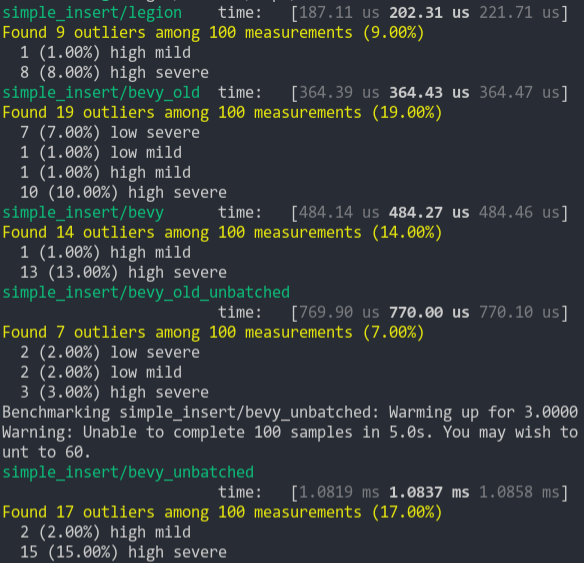
### Simpler Iter (from ecs_bench_suite)
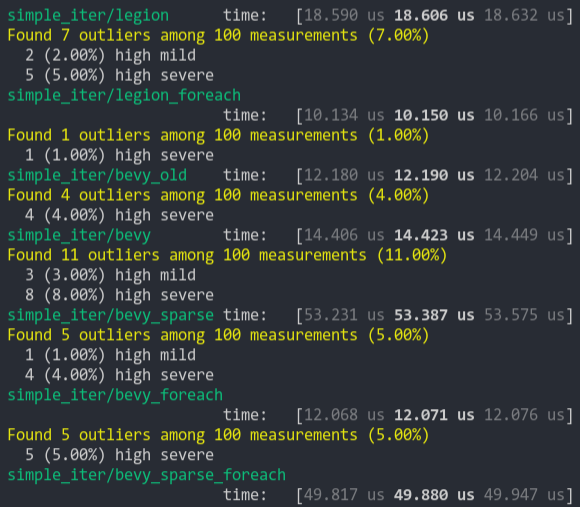
### Fragment Iter (from ecs_bench_suite)
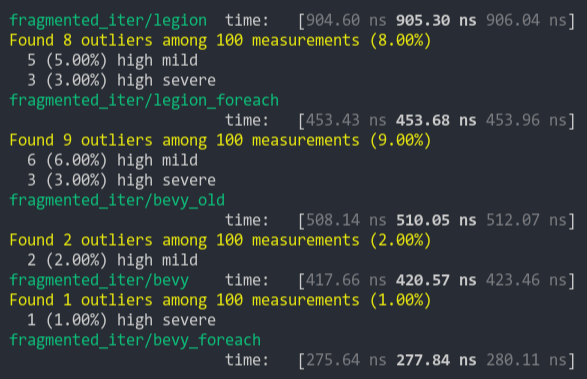
### Sparse Fragmented Iter
Iterate a query that matches 5 entities from a single matching archetype, but there are 100 unmatching archetypes
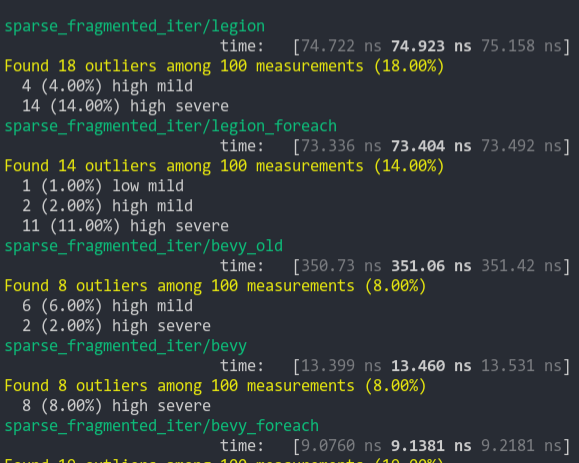
### Schedule (from ecs_bench_suite)
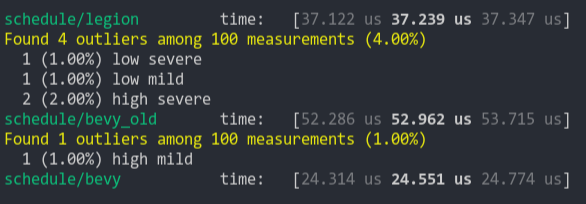
### Add Remove Component (from ecs_bench_suite)
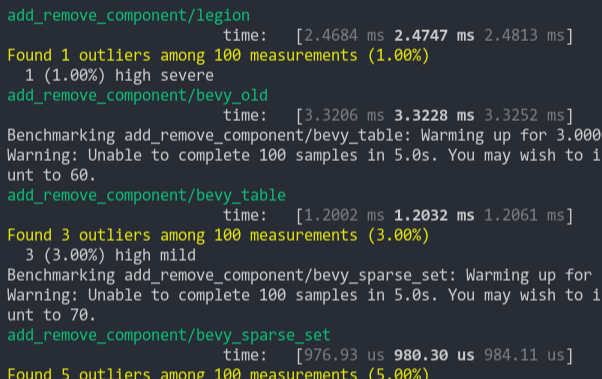
### Add Remove Component Big
Same as the test above, but each entity has 5 "large" matrix components and 1 "large" matrix component is added and removed
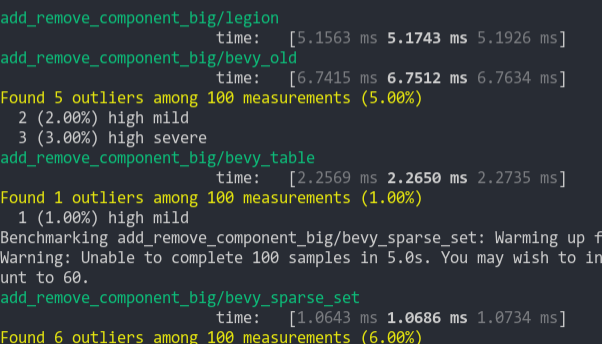
### Get Component
Looks up a single component value a large number of times
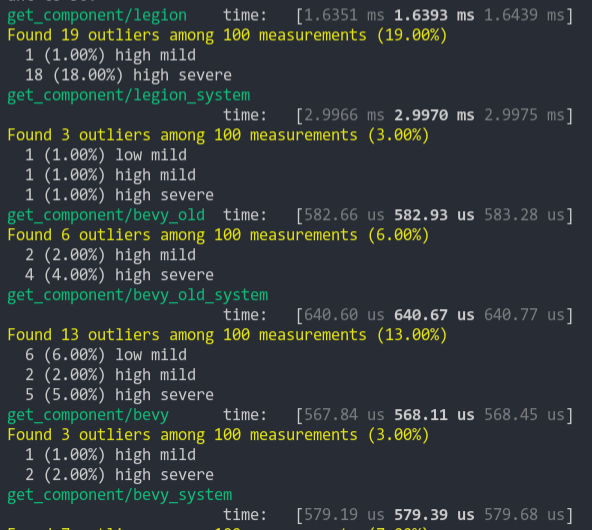
OK, here's my attempt at sprite flipping. There are a couple of points that I need review/help on, but I think the UX is about ideal:
```rust
.spawn(SpriteBundle {
material: materials.add(texture_handle.into()),
sprite: Sprite {
// Flip the sprite along the x axis
flip: SpriteFlip { x: true, y: false },
..Default::default()
},
..Default::default()
});
```
Now for the issues. The big issue is that for some reason, when flipping the UVs on the sprite, there is a light "bleeding" or whatever you call it where the UV tries to sample past the texture boundry and ends up clipping. This is only noticed when resizing the window, though. You can see a screenshot below.

I am quite baffled why the texture sampling is overrunning like it is and could use some guidance if anybody knows what might be wrong.
The other issue, which I just worked around, is that I had to remove the `#[render_resources(from_self)]` annotation from the Spritesheet because the `SpriteFlip` render resource wasn't being picked up properly in the shader when using it. I'm not sure what the cause of that was, but by removing the annotation and re-organizing the shader inputs accordingly the problem was fixed.
I'm not sure if this is the most efficient way to do this or if there is a better way, but I wanted to try it out if only for the learning experience. Let me know what you think!
* add normalized orthographic projection
* custom scale for ScaledOrthographicProjection
* allow choosing base axis for ScaledOrthographicProjection
* cargo fmt
* add general (scaled) orthographic camera bundle
FIXME: does the same "far" trick from Camera2DBundle make any sense here?
* fixes
* camera bundles: rename and new ortho constructors
* unify orthographic projections
* give PerspectiveCameraBundle constructors like those of OrthographicCameraBundle
* update examples with new camera bundle syntax
* rename CameraUiBundle to UiCameraBundle
* update examples
* ScalingMode::None
* remove extra blank lines
* sane default bounds for orthographic projection
* fix alien_cake_addict example
* reorder ScalingMode enum variants
* ios example fix